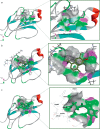Pharmacoinformatic Approach to Explore the Antidote Potential of Phytochemicals on Bungarotoxin from Indian Krait, Bungarus caeruleus
- PMID: 30455855
- PMCID: PMC6231056
- DOI: 10.1016/j.csbj.2018.10.005
Pharmacoinformatic Approach to Explore the Antidote Potential of Phytochemicals on Bungarotoxin from Indian Krait, Bungarus caeruleus
Abstract
Venomous reptiles especially serpents are well known for their adverse effects after accidental conflicts with humans. Upon biting humans these serpents transmit arrays of detrimental toxins with diverse physiological activities that may either lead to minor symptoms such as dermatitis and allergic response or highly severe symptoms such as blood coagulation, disseminated intravascular coagulation, tissue injury, and hemorrhage. Other complications like respiratory arrest and necrosis may also occur. Bungarotoxins are a group of closely related neurotoxic proteins derived from the venom of kraits (Bungarus caeruleus) one of the six most poisonous snakes in India whose bite causes respiratory paralysis and mortality without showing any local symptoms. In the current study, by employing various pharmacoinformatic approaches, we have explored the antidote properties of 849 bioactive phytochemicals from 82 medicinal plants which have already shown antidote properties against various venomous toxins. These herbal compounds were taken and pharmacoinformatic approaches such as ADMET, docking and molecular dynamics were employed. The three-dimensional modelling approach provides structural insights on the interaction between bungarotoxin and phytochemicals. In silico simulations proved to be an effective analytical tools to investigate the toxin-ligand interaction, correlating with the affinity of binding. By analyzing the results from the present study, we proposed nine bioactive phytochemical compounds which are, 2-dodecanol, 7-hydroxycadalene, indole-3-(4'-oxo)butyric acid, nerolidol-2, trans-nerolidol, eugenol, benzene propanoic acid, 2-methyl-1-undecanol, germacren-4-ol can be used as antidotes for bungarotoxin.
Keywords: Bungarotoxin; Drug design; Molecular docking; Molecular dynamics; Pharmacokinetic profiling; Toxins.
Figures










Similar articles
-
Venomics of Bungarus caeruleus (Indian krait): Comparable venom profiles, variable immunoreactivities among specimens from Sri Lanka, India and Pakistan.J Proteomics. 2017 Jul 5;164:1-18. doi: 10.1016/j.jprot.2017.04.018. Epub 2017 May 2. J Proteomics. 2017. PMID: 28476572
-
A Wolf in Another Wolf's Clothing: Post-Genomic Regulation Dictates Venom Profiles of Medically-Important Cryptic Kraits in India.Toxins (Basel). 2021 Jan 19;13(1):69. doi: 10.3390/toxins13010069. Toxins (Basel). 2021. PMID: 33477742 Free PMC article.
-
Venom proteome of Bungarus sindanus (Sind krait) from Pakistan and in vivo cross-neutralization of toxicity using an Indian polyvalent antivenom.J Proteomics. 2019 Feb 20;193:243-254. doi: 10.1016/j.jprot.2018.10.016. Epub 2018 Oct 29. J Proteomics. 2019. PMID: 30385415
-
The concept of Big Four: Road map from snakebite epidemiology to antivenom efficacy.Int J Biol Macromol. 2023 Jul 1;242(Pt 1):124771. doi: 10.1016/j.ijbiomac.2023.124771. Epub 2023 May 9. Int J Biol Macromol. 2023. PMID: 37169043 Review.
-
Pharmacological re-assessment of traditional medicinal plants-derived inhibitors as antidotes against snakebite envenoming: A critical review.J Ethnopharmacol. 2022 Jun 28;292:115208. doi: 10.1016/j.jep.2022.115208. Epub 2022 Mar 18. J Ethnopharmacol. 2022. PMID: 35314419 Review.
Cited by
-
C ucumis melo compounds: A new avenue for ALR-2 inhibition in diabetes mellitus.Heliyon. 2024 Jul 27;10(15):e35255. doi: 10.1016/j.heliyon.2024.e35255. eCollection 2024 Aug 15. Heliyon. 2024. PMID: 39170458 Free PMC article.
-
Graph theoretical network analysis, in silico exploration, and validation of bioactive compounds from Cynodon dactylon as potential neuroprotective agents against α-synuclein.Bioimpacts. 2022;12(6):487-499. doi: 10.34172/bi.2022.24113. Epub 2022 Oct 30. Bioimpacts. 2022. PMID: 36644543 Free PMC article.
-
An Appraisal of Antidotes' Effectiveness: Evidence of the Use of Phyto-Antidotes and Biotechnological Advancements.Molecules. 2020 Mar 26;25(7):1516. doi: 10.3390/molecules25071516. Molecules. 2020. PMID: 32225103 Free PMC article. Review.
-
Pharmacoinformatics-based investigation of bioactive compounds of Rasam (South Indian recipe) against human cancer.Sci Rep. 2021 Nov 2;11(1):21488. doi: 10.1038/s41598-021-01008-9. Sci Rep. 2021. PMID: 34728718 Free PMC article.
-
Proliferative Effect of Aqueous Extract of Sea Cucumber (Holothuria parva) Body Wall on Human Umbilical Cord Mesenchymal Stromal/Stem Cells.Mar Drugs. 2023 Apr 26;21(5):267. doi: 10.3390/md21050267. Mar Drugs. 2023. PMID: 37233461 Free PMC article.
References
-
- Mackessy S.P. CRC Press; 2016. Handbook of venoms and toxins of reptiles.
-
- Chang C.C. Looking back on the discovery of alpha-bungarotoxin. J Biomed Sci. 1999;6(6):368–375. - PubMed
LinkOut - more resources
Full Text Sources
